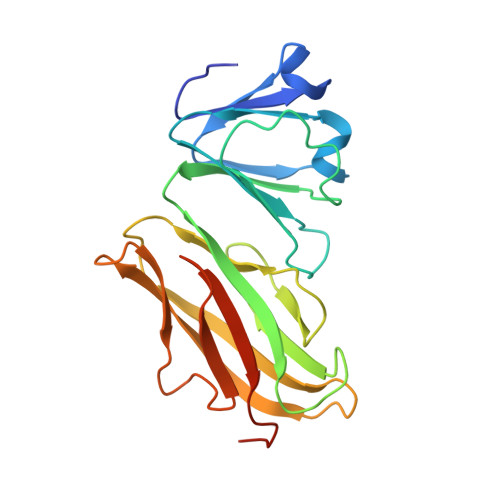Interface interactions between beta gamma-crystallin domain and Ig-like domain render Ca2+-binding site inoperative in abundant perithecial protein of Neurospora crassa.
Swaroop Srivastava, S., Raman, R., Kiran, U., Garg, R., Chadalawada, S., Pawar, A.D., Sankaranarayanan, R., Sharma, Y.(2018) Mol Microbiol 110: 955-972
- PubMed: 30216631
- DOI: https://doi.org/10.1111/mmi.14130
- Primary Citation of Related Structures:
5Z6D, 5Z6E - PubMed Abstract:
We describe a set of proteins in which a βγ-crystallin domain pairs with an Ig-like domain, and which are confined to microbes, like bacteria, slime molds and fungi. DdCAD-1 (Ca 2+ -dependent cell adhesion molecule-1) and abundant perithecial protein (APP) represent this class of molecules. Using the crystal structure of APP-NTD (N-terminal domain of APP), we describe its mode of Ca 2+ binding and provide a generalized theme for correct identification of the Ca 2+ -binding site within this class of molecules. As a common feature, one of the two Ca 2+ -binding sites is non-functional in the βγ-crystallin domains of these proteins. While APP-NTD binds Ca 2+ with a micromolar affinity which is comparable to DdCAD-1, APP surprisingly does not bind Ca 2+ . Crystal structures of APP and Ca 2+ -bound APP-NTD reveal that the interface interactions in APP render its Ca 2+ -binding site inoperative. Thus, heterodomain association provides a novel mode of Ca 2+ -binding regulation in APP. Breaking the interface interactions (mutating Asp30Ala, Leu132Ala and Ile135Ala) or separation from the Ig-like domain removes the constraints upon the required conformational transition and enables the βγ-crystallin domain to bind Ca 2+ . In mechanistic detail, our work demonstrates an interdomain interface adapted to distinct functional niches in APP and its homolog DdCAD-1.
Organizational Affiliation:
CSIR - Centre for Cellular and Molecular Biology (CCMB), Hyderabad, 500 007, India.














